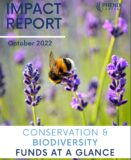Phenix Capital Group has released today its Conservation & Biodiversity Funds Report, revealing that capital commitments have had an inconsistent inflow over the past 7 years. Conservation and biodiversity funds launched in 2020 fundraised the most, which caused the number of funds launched the following year, in 2021, to reach a record high. However, forecasted fundraising didn’t meet expectations. This led to a significant discrepancy in 2021, which saw the capital committed drop significantly.
Post 2020, we saw a decline of 55% year over year in capital commitments towards Conservation & Biodiversity. This was due to many factors, ranging from a worldwide pandemic to investors preference for other impact themes such as Circular Economy, Net-zero, and others.
Other key report takeaways
- The emergence of green bonds in public debt has been paramount. In fact, there was nearly 15 billion euros of capital committed towards global markets. This figure accounts for more than 80% of all the allocated capital towards this market within public debt
- In parallel, real assets are heavily focused on developing markets, accounting for 2/3 of allocated capital
- The weight of capital amongst other asset classes also lies heavily in favour of developing markets, showing public debt is the outlier.
Funds targeting Conservation & Biodiversity represent 6.5% of funds from Phenix Capital’s Impact Database. The majority of funds targeting Conservation and Biodiversity are open for investments. This presents a ripe opportunity for investors trying to enter the space. We are yet to see the result of funds with 2022 as vintage – funds launched this year are still being counted.
Graph from the Phenix Capital Group’s Impact Report on Conservation & Biodiversity Funds, revealing inconsistent capital flow through the years and the record of capital commitments in 2020 followed by an unexpected drop in 2021.








